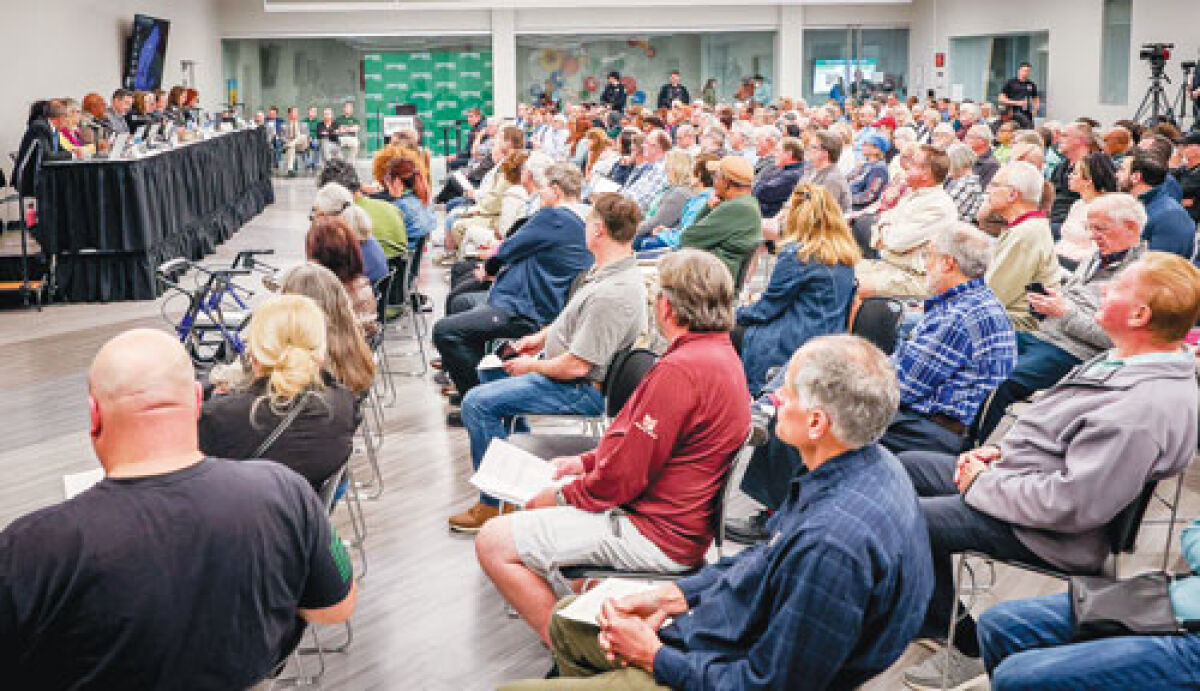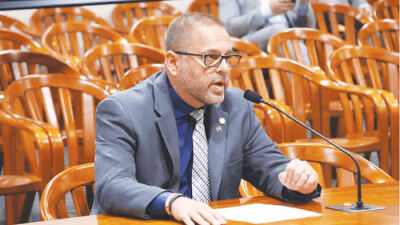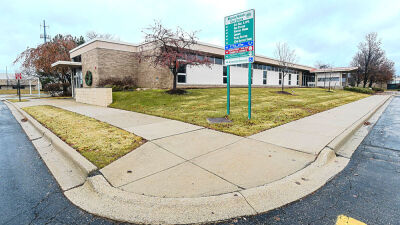
Councilman Michael Bridges, the sole dissenter, votes “no” on the resolution to hunt and cull.
Photo by Patricia O’Blenes
FARMINGTON HILLS — The Farmington Hills City Council recently passed a resolution to reduce the deer population through hunting and culling methods.
The council approved the resolution, 6-1, at its April 28 meeting, held at The Hawk in Harrison Hall instead of the usual council chambers at City Hall.
The 200-seat room was chosen to better accommodate the public but still filled to the brim, with overflow in the hallway and nearby rooms.
Passions were high among those in attendance. There was a discernible divide between those who were supportive of hunting and culling and those who weren’t.
Farmington Hills Mayor Theresa Rich struck her gavel several times, asking for order and for those in the audience not to respond with talking, clapping or laughing.
Members of the study presented their findings on reducing the deer population in the city. Participants included Bryan Farmer, deputy director of special services in Farmington Hills, and Chad Fedewa, a wildlife biologist with the Michigan Department of Natural Resources.
They determined hunts and culls were the only way to reduce the deer population.
This position was met with resistance by a significant number of residents in attendance, who referred to the plan as “killing” and “murdering,” and requested council to take a “more humane” and “nonlethal approach.”
Councilman Michael Bridges was the council’s lone dissenter. He felt that the data presented by Farmer lacked thoroughness and objectivity because Farmer did not communicate to council and the public the efforts already taken to reduce the deer population and to educate the public on the matter in his first study session address March 24.
“It calls into question (your conclusions),” Bridges said. “You are searching for data to (support) your position.”
When asked why he didn’t initially present this information, Farmer replied, “I can spend days presenting a lot of information to the City Council. … We wanted to sum it up. … You indicated you wanted to hear more information about education. … So, we included it.”
One lifelong resident, Karen Amick, had concerns. She felt the council should explore other options for reducing the herd, such as birth control, which she said is known to be effective.
Others at the meeting called the deer “beautiful,” but supported the resolution to hunt and cull the herd because of the tens of thousands of dollars in private property damage caused by the deer during frequent visits to their homes and yards.
The resolution would call for highly regulated archery hunting that would be limited to trained public safety personnel. The council requested this language was added to the resolution. All other portions of the resolution were adopted as written.
The culls would consist of contracted professional sharpshooters who would be active for two to five days starting in 2026. According to the council, this will be reviewed, and the number of days for the cull may increase.
This will involve sharpshooters with the U.S. Department of Agriculture (USDA) using suppressed rifles and thermal imaging at night. Sharpshooters will be positioned to take safe and accurate shots, according to a city statement.
Culls will occur in accordance with regulatory agencies, according to a city statement. The location of culls will be determined by looking at impact data from across the city.
As for archery hunts, those will also be highly regulated. They will be performed by trained public safety personnel using bows and crossbows, with the hunters elevated or in a tree to shoot arrows toward the ground.
According to Farmer, the hunters will not shoot the arrows if children are in the area.
For culls or hunts, ordinances prohibiting the discharge of a firearm or being in possession of a bow will be suspended for a limited time. Venison harvested from the kills will be processed and donated to local food banks.
The city will continue collecting data on deer-vehicle crashes and deer carcass pickup, while monitoring any ecological impacts and listening to the concerns of residents.
A deer management report will be provided annually to the council, and the deer management plan will be reviewed every five years as part of the city’s parks and recreation master plan.
“We’re not looking to eradicate the deer in the city of Farmington Hills,” Farmer said. “We’re looking to reduce the population, to be more of a healthy herd (and) more sustainable.”
 Publication select ▼
Publication select ▼























